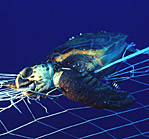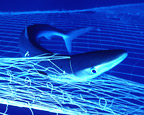Our Captain, Mike McGettigan is the founder of Sea Watch (http://www.seawatch.org), an organization dedicated to the preservation of endangered marine life in Baja California. As usual, Mike was up early as we appreciated the island. During his trip around the island, he noted 7 Mexican fishing vessels. We hoped they were just passing through. Consultation with another vessel told us that this was there 7th day at the Island. The Revillagigedo Archipelago is a Mexican reserve, which allows limited sportsfishing but prohibits commercial fishing. We notified the vessels that commercial fishing was illegal but their response was to ignore us. Early the first day, we swam with the mantas and late in the day we left the famous boiler rock for another trip around the island where we saw the commercial boats deploying their nets. On our return trip we were shocked to find a net deployed directly over the boiler (manta city). With help from the vessel Solmar V we were able to convince this particular boat to move. They moved a mile away. Early the next morning we witnessed the agonizing lethality of just one night's set of the nets. The nets are 4 miles long supported with about 50 buoys. The top of the nets are about 40 feet deep and the bottom is about 100 feet deep. We swam the entire length of one net and found two dead animals (mostly sharks) for every buoy. That is about 100 sharks per boat. Seven boats netting each of the 7 days calculates to the removal of at least 4,900 sharks. The boats were covered with shark fins drying on every available space. What was very disturbing was the way in which these animals died. Sometimes the sharks twisted so violently in the nets that they rolled up the entire net from top to bottom. Many of the sharks we so obscured by the wrapped nets that they appeared to be in cocoons, their fins folded over their chests as if in prayer. It was hideous! One could just imagine the unwary animal swimming at night. Brushing the net it would turn or swim faster (sharks and rays cannot swim backward). Each turn or thrust would strangle and entangle it more. The loss of marine life was staggering. Where we were used to seeing dozens of sharks in previous years on each dive, no sharks were seen alive during the entire time we visited this Island. How many turtles and manta rays do we have to spare? It is our sincere hope that the Mexican authorities act on this practice and enforce the ban on commercial fishing. Terry Maas, Ron Mullins, Bob Bachmann, Jim Mabry, Bob Jackson, Derek Stavenger, Mike McGettigan and Sherry Shaffer--crew and guests of the Ambar III, May 2000. (Story and photos © Terry Maas 2000 all rights reserved)
Blue Water Freediverws Home Page
|






